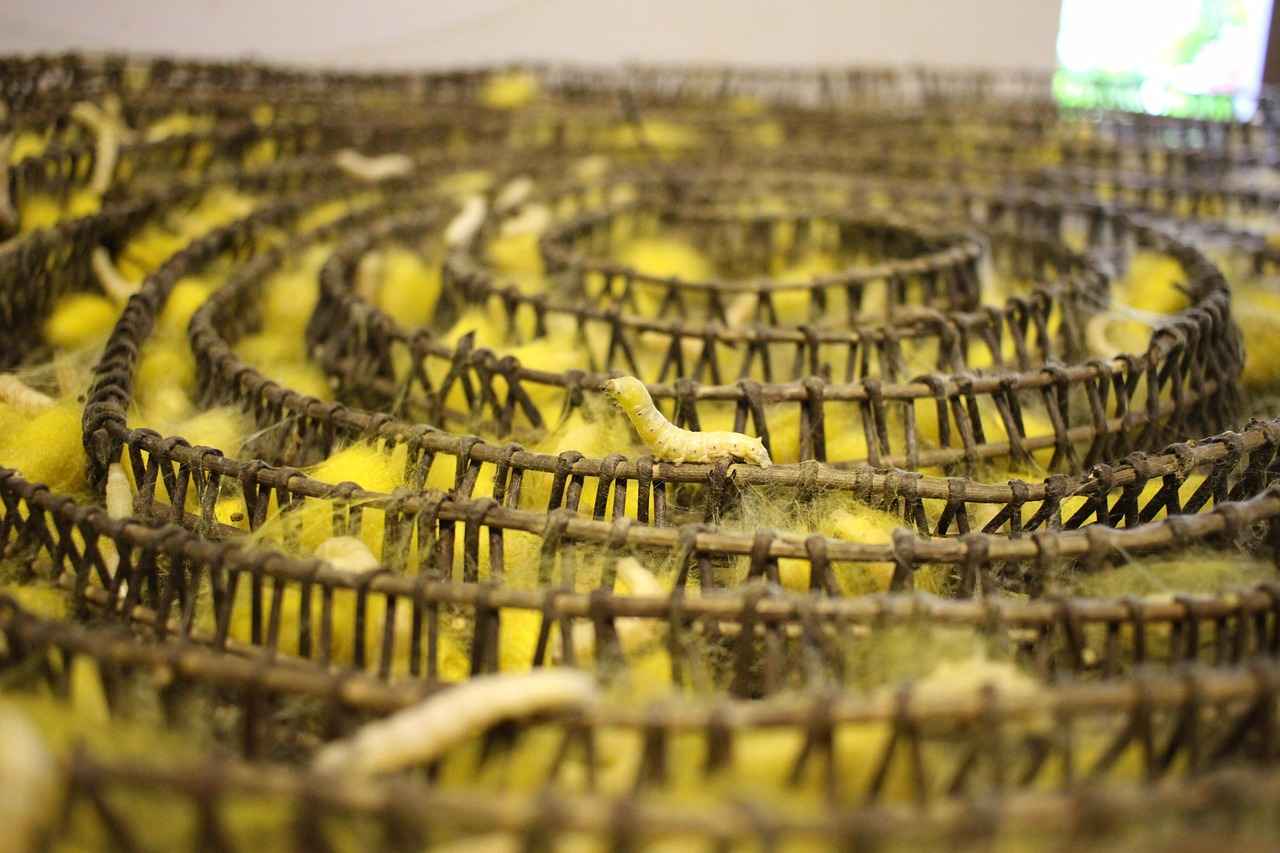This article delves into the significant reasons for avoiding direct sunlight when drying silk slip dresses. Silk is a luxurious fabric that deserves special care to maintain its beauty and longevity. Understanding the effects of sunlight on silk can help you keep your garments looking stunning for years to come.
What Happens to Silk in Direct Sunlight?
Exposing silk to direct sunlight can lead to severe consequences. The intense rays can cause the fabric to fade and become weakened, compromising its integrity. This is particularly important for silk slip dresses, which are often worn for special occasions and need to maintain their elegance.
Why Is Silk a Delicate Fabric?
Silk is a natural protein fiber derived from silkworms, making it inherently delicate. Its soft texture and luxurious sheen come at a cost; silk is highly susceptible to damage from environmental factors, including UV rays from the sun. Proper care is essential for preserving its exquisite qualities.
How Does UV Exposure Affect Silk?
Ultraviolet (UV) rays can break down silk fibers, leading to discoloration and brittleness. Recognizing the impact of UV exposure is vital for silk care. Over time, prolonged exposure can result in irreversible damage, diminishing the dress’s overall appearance.
What Are the Signs of Sun Damage on Silk?
- Faded colors
- Rough texture
- Loss of luster
Identifying these signs early can help prevent further deterioration. If you notice any of these symptoms, reconsider your drying methods.
Can Silk Recover from Sun Damage?
While some minor damage can be repaired, extensive sun exposure may be irreversible. It is crucial to understand recovery options, such as professional cleaning, to assist in garment maintenance and restoration.
Why Should You Avoid Heat When Drying Silk?
Heat can cause silk fibers to shrink and distort, altering the fit and feel of your dress. Learning proper drying methods is essential to maintain its original shape and beauty.
What Are the Best Drying Methods for Silk?
Choosing the right drying technique is essential for preserving silk. Here are some effective methods:
- Air Drying: The safest way to dry silk is by air drying, which minimizes the risk of heat damage and helps maintain the fabric’s natural luster.
- Using a Towel to Absorb Moisture: Placing your silk dress flat on a towel can effectively absorb excess moisture without causing stress to the fabric.
How to Store Your Silk Slip Dress Properly?
Proper storage is crucial for maintaining the quality of your silk. Here are some best practices:
- Avoid hanging silk dresses in direct sunlight.
- Store in a cool, dry place to prevent damage from humidity.
How to Fold Silk for Storage?
Folding silk correctly can help maintain its shape and prevent creasing. Always fold along the seams and place tissue paper between layers to avoid marks.
What Are Common Myths About Silk Care?
Many misconceptions surround silk care. Here are a few:
- Is Silk Machine Washable? While some may believe silk can be machine washed, this is often not recommended due to the risk of damage.
- Can You Iron Silk on High Heat? Ironing silk on high heat can cause burns and damage, so it’s essential to know the appropriate settings.

What Happens to Silk in Direct Sunlight?
Silk is renowned for its luxurious feel and elegant appearance, but it is also a delicate fabric that requires special care to maintain its beauty. One of the most significant threats to silk garments is direct sunlight. Understanding the implications of exposing silk to sunlight is crucial for anyone looking to preserve their silk items, especially slip dresses. This section delves into the specific effects of sunlight on silk and provides valuable insights for proper care.
When silk is exposed to direct sunlight, it undergoes several detrimental changes. First and foremost, the color of the fabric can fade significantly. This fading occurs due to the breakdown of the dye molecules in the silk fibers, which can leave your once-vibrant slip dress looking dull and lifeless. Over time, this exposure can lead to irreversible discoloration, making it essential to take preventive measures.
In addition to fading, prolonged exposure to sunlight can also weaken the silk fibers themselves. The UV rays present in sunlight can break down the protein structure of silk, resulting in a loss of tensile strength. This means that the fabric may become more prone to tearing and fraying, compromising the integrity of your garment. Understanding these effects is not just about aesthetics; it’s about maintaining the quality and durability of your silk pieces.
Silk is a natural protein fiber derived from the cocoons of silkworms, which contributes to its luxurious texture but also makes it particularly sensitive to environmental factors. Its delicate nature means that silk can easily be affected by moisture, heat, and of course, sunlight. Each of these elements can lead to various forms of damage, including fading, shrinking, and even distortion of the fabric.
Ultraviolet (UV) rays are notorious for their damaging effects on various materials, and silk is no exception. When silk is exposed to UV radiation, the fibers can become brittle and lose their natural elasticity. This degradation not only affects the appearance of the fabric but can also impact its feel, making it less comfortable to wear. Recognizing the impact of UV exposure is vital for anyone who owns silk garments.
- Faded Colors: One of the most noticeable signs of sun damage is a significant loss of color vibrancy.
- Rough Texture: Silk that has been damaged by sunlight may feel coarse or rough to the touch.
- Weakness: You may notice that the fabric tears more easily or shows signs of wear.
Identifying these signs early can help you take action to prevent further deterioration and preserve your garments for years to come.
While some minor damage can be repaired, extensive sun exposure may lead to irreversible changes in the fabric. If you notice early signs of fading or texture changes, there are options to restore your silk to some extent. Professional cleaning and dyeing services can sometimes revitalize the color and feel of sun-damaged silk. However, understanding the limits of recovery is crucial for managing expectations.
To protect your silk garments, it is essential to choose the right drying techniques. Here are some recommended methods:
- Air Drying: This is the safest method for drying silk. It minimizes the risk of heat damage and helps maintain the fabric’s natural luster.
- Using a Towel: Placing your silk dress flat on a towel can effectively absorb excess moisture without causing stress to the fabric.
By following these drying methods, you can significantly extend the life of your silk garments and keep them looking their best.

Why Is Silk a Delicate Fabric?
Silk is often celebrated for its luxurious feel and elegant appearance, but it is also recognized as a delicate fabric that requires careful handling and maintenance. Understanding the reasons behind its fragility can help you preserve your silk garments for years to come. This article delves into the nature of silk, the factors that contribute to its delicacy, and practical tips for ensuring its longevity.
Silk is a natural protein fiber produced by silkworms. Its unique composition gives it a beautiful sheen and softness, but also makes it vulnerable to various environmental factors. The following points highlight why silk is considered a delicate fabric:
- Environmental Sensitivity: Silk is highly susceptible to damage from environmental elements such as sunlight, moisture, and heat. Exposure to these factors can lead to fading, weakening, and even irreversible damage.
- Structure of Silk Fibers: The molecular structure of silk fibers is complex and can be easily disrupted. This makes them prone to breakage when subjected to stress or harsh conditions.
- Absorption Properties: Silk has excellent moisture-wicking abilities, but it can also absorb stains and odors quickly. This necessitates gentle cleaning methods to avoid damage.
Direct exposure to sunlight can have detrimental effects on silk. The ultraviolet (UV) rays can break down the fiber’s structure, leading to:
- Fading: Over time, colors can become dull and lifeless, stripping the garment of its original vibrancy.
- Brittleness: Prolonged exposure can weaken the fibers, making them more prone to tearing and fraying.
Recognizing the signs of sun damage early can help you take action to mitigate further deterioration. Common indicators include:
- Discoloration: Noticeable fading, particularly in areas that receive the most sunlight.
- Texture Changes: A rough or stiff texture can indicate that the silk has been compromised.
While minor sun damage can sometimes be repaired through professional cleaning or restoration, extensive damage may be irreversible. It is crucial to take preventive measures to avoid such situations.
To maintain the beauty and integrity of your silk garments, consider the following care tips:
- Air Drying: Always air dry silk garments away from direct sunlight to prevent fading and damage.
- Storage: Store silk in a cool, dry place, ideally folded rather than hung, to prevent stretching and distortion.
- Gentle Cleaning: Opt for hand washing or dry cleaning to preserve the fabric’s quality.
Many myths surround the care of silk, which can lead to improper handling. For instance:
- Machine Washing: While some believe silk can be machine washed, this is generally not recommended due to the risk of damage.
- High Heat Ironing: Ironing silk on high heat can cause burns and irreversible damage. Always use a low heat setting and a protective cloth.
By understanding the delicate nature of silk and implementing proper care techniques, you can ensure that your silk garments remain beautiful and timeless.
How Does UV Exposure Affect Silk?
Silk, known for its luxurious feel and elegant drape, is a fabric that requires special attention to maintain its beauty. One of the most significant threats to silk is ultraviolet (UV) exposure. Understanding how UV rays affect silk is essential for anyone looking to preserve their favorite silk garments, such as slip dresses.
When silk is exposed to direct sunlight, the ultraviolet rays can initiate a chemical breakdown of the silk fibers. This process leads to a range of damaging effects:
- Fading Colors: Prolonged exposure to sunlight can cause vibrant colors to lose their richness, resulting in an overall dull appearance.
- Brittleness: The structure of silk fibers weakens under UV exposure, making them more prone to tears and damage.
- Loss of Luster: Silk’s natural sheen diminishes, affecting its luxurious look and feel.
Silk is a natural protein fiber derived from silkworms, making it inherently delicate. Unlike synthetic fibers, which may have UV-resistant properties, silk lacks these defenses, making it particularly vulnerable to environmental factors. Its delicate nature means that even short periods of exposure to sunlight can lead to irreversible damage.
Identifying the signs of sun damage early can help you take preventive measures. Common indicators include:
- Faded Areas: Look for patches where the color appears washed out.
- Texture Changes: A rough or coarse feel can indicate that the fibers have been compromised.
- Visible Fraying: Check the edges and seams for any signs of wear or tear.
While minor damage may be repairable through professional cleaning or restoration, extensive sun exposure can lead to permanent changes in the fabric. It’s crucial to assess the level of damage and consult with a specialist if you notice significant deterioration.
To ensure your silk garments remain in pristine condition, consider the following protective measures:
- Avoid Direct Sunlight: Always dry your silk garments in the shade or indoors to prevent UV damage.
- Use UV-Blocking Curtains: If storing silk indoors, consider using curtains that block UV rays.
- Store Properly: When not in use, keep silk items in a cool, dark place to minimize exposure.
Proper care not only protects silk from UV damage but also enhances its longevity. Regularly cleaning your silk items according to care instructions, avoiding harsh chemicals, and using gentle detergents can help maintain the fabric’s integrity. Additionally, consider air drying instead of using heat, as this minimizes the risk of damage.
In summary, understanding the impact of UV exposure on silk is crucial for maintaining the beauty and longevity of your favorite silk garments. By taking proactive steps to protect silk from sunlight and following best care practices, you can enjoy these luxurious fabrics for years to come.
What Are the Signs of Sun Damage on Silk?
Silk is a luxurious fabric, cherished for its softness and sheen. However, it is also highly sensitive to environmental factors, particularly sunlight. Understanding the signs of sun damage on silk is essential for maintaining its beauty and longevity.
Recognizing the signs of sun damage early can help you take preventive measures to protect your silk garments. Here are some common indicators:
- Faded Colors: One of the most noticeable signs of sun damage is a change in color. Silk can lose its vibrant hues and appear dull or washed out when exposed to prolonged sunlight.
- Rough Texture: Sun exposure can cause the smooth surface of silk to become rough and coarse. This change in texture is a clear indication that the fabric has been compromised.
- Weak Fibers: Over time, UV rays can weaken the silk fibers, making them more susceptible to tearing and fraying. If your silk dress feels less resilient, it may be a sign of sun damage.
- Discoloration: In addition to fading, you may notice uneven patches or spots on the fabric. These discolorations can occur due to uneven exposure to sunlight.
- Loss of Luster: Silk is known for its natural sheen. If your garment appears less shiny than before, it may be a result of sun exposure degrading the fibers.
Being aware of these signs can help you identify sun damage early. If you notice any of these indicators, it’s crucial to act quickly to prevent further deterioration.
Preventing sun damage is much easier than trying to repair it. Here are some practical tips to protect your silk garments:
- Avoid Direct Sunlight: When drying your silk slip dress, always choose a shaded area. Direct sunlight can accelerate fading and weaken the fabric.
- Use a Clothesline in the Shade: If you must air dry your silk, consider using a clothesline or drying rack in a shaded spot to minimize UV exposure.
- Store Properly: When not in use, store your silk garments in a cool, dark place. Avoid hanging them in direct sunlight or in damp conditions.
- Use UV-Blocking Products: Consider using UV-blocking sprays or fabrics to add an extra layer of protection against sunlight.
By implementing these preventive measures, you can significantly reduce the risk of sun damage and extend the life of your silk garments.
While minor sun damage may be reversible, extensive damage can be challenging to fix. Here are some options:
- Professional Cleaning: A professional dry cleaner may be able to restore some of the silk’s original color and texture.
- Fabric Dyeing: If fading is severe, consider dyeing the fabric to restore its color, but consult with a specialist first.
- Repairing Tears: Small tears or frays can often be repaired by a skilled tailor, preserving the garment’s integrity.
In conclusion, being vigilant about the signs of sun damage on silk can help you maintain your garments in pristine condition. By taking proactive steps to protect your silk, you can enjoy its beauty and elegance for years to come.
Can Silk Recover from Sun Damage?
Silk is renowned for its luxurious feel and elegant appearance, but it is also a delicate fabric that requires special care. Among the various factors that can affect silk, **sun exposure** is particularly damaging. Understanding how silk reacts to sunlight and what can be done to mitigate the effects of sun damage is essential for maintaining the beauty and longevity of silk garments.
When it comes to sun damage, the extent of the damage plays a critical role in determining whether recovery is possible. **Minor damage**, such as slight fading or a change in texture, may be reversible with proper care. However, **extensive sun exposure** can lead to irreversible changes that compromise the fabric’s integrity.
One of the most common signs of sun damage is **fading**. Over time, UV rays can break down the dye molecules in silk, leading to a washed-out appearance. If you notice your silk slip dress has lost its vibrant colors, there are a few steps you can take to help restore its original beauty:
- Professional Cleaning: Consider taking your silk garment to a professional cleaner who specializes in delicate fabrics. They may have specialized techniques to restore color and texture.
- Color Restorers: Some products are designed to help revive the color of faded fabrics. Always test on a small, inconspicuous area first to ensure compatibility.
- Gentle Washing: If the care label permits, gently wash your silk in cool water with a mild detergent. This can help remove any dirt or oils that may have contributed to the faded appearance.
Another effect of prolonged sun exposure is the weakening of silk fibers, which can lead to brittleness and tearing. If your silk dress feels rough or fragile, it may be a sign that the fibers have been compromised. While minor roughness can sometimes be improved through gentle washing and conditioning, significant weakening often requires more drastic measures:
- Repairing Tears: If you notice small tears, consult a tailor who can reinforce the fabric and help prevent further damage.
- Reweaving: For larger areas of damage, professional reweaving may be necessary. This technique can restore the garment’s structure but can be costly.
It is important to recognize that while some minor damage can be repaired, extensive sun exposure may be irreversible. **Understanding recovery options** can assist in garment maintenance, but prevention is always the best strategy. To protect your silk slip dress from sun damage, consider the following tips:
- Store Away from Sunlight: Keep your silk garments in a cool, dark place to prevent fading.
- Use UV-Blocking Covers: If you must display your silk dresses, consider using UV-blocking covers or curtains to minimize direct sunlight exposure.
- Limit Outdoor Use: When wearing silk in sunny conditions, try to stay in shaded areas to reduce direct exposure.
Ultimately, while some recovery options exist for silk damaged by sunlight, the best approach is to take proactive measures to prevent damage in the first place. By understanding the delicate nature of silk and implementing proper care techniques, you can ensure that your silk garments remain beautiful for years to come.
Why Should You Avoid Heat When Drying Silk?
Silk is a luxurious fabric known for its softness and sheen, but it is also notoriously delicate. One of the most critical aspects of caring for silk garments, such as your favorite slip dress, is understanding the effects of heat during the drying process. In this section, we will explore why you should avoid heat when drying silk and how to protect your cherished pieces from damage.
Heat can have a detrimental effect on silk fibers. When silk is subjected to high temperatures, it can lead to shrinkage and distortion. This alteration not only changes the fit of your dress but also affects its overall feel and appearance. The fibers can become brittle, resulting in a loss of that signature luxurious texture that silk is known for.
Silk is a natural protein fiber derived from the cocoons of silkworms. Its delicate structure makes it particularly sensitive to temperature fluctuations. When exposed to heat, the protein bonds within the silk can break down, leading to irreversible damage. This is why it is crucial to handle silk with care and to avoid any drying methods that involve heat.
- Air Drying: The safest and most recommended method for drying silk is air drying. Lay your silk dress flat on a clean, dry towel to absorb moisture, then allow it to air dry away from direct sunlight.
- Using a Towel: After washing, gently roll your silk dress in a towel to remove excess water. This method is gentle and minimizes stress on the fabric.
- Avoiding Direct Sunlight: Always dry silk in a shaded area to prevent fading and weakening of the fibers due to UV exposure.
Improper drying techniques can significantly reduce the lifespan of your silk garments. Heat exposure can lead to permanent damage, making your dress unwearable over time. By adhering to proper drying methods, you can maintain the original beauty and structure of your silk slip dress.
Recognizing the signs of heat damage is essential for timely intervention. Common indicators include:
- Faded Colors: A noticeable loss of vibrancy in the fabric.
- Brittle Texture: The fabric may feel rough or crispy instead of soft and smooth.
- Shrinking: The dress may no longer fit as intended, leading to discomfort.
While some minor heat damage can be mitigated through professional cleaning or steaming, extensive damage may be irreversible. It’s vital to take preventive measures to avoid such situations in the first place. Understanding the risks associated with heat exposure can help you make informed decisions about the care of your silk garments.
In conclusion, avoiding heat when drying silk is crucial for preserving the fabric’s integrity and ensuring your slip dress remains a staple in your wardrobe for years to come. By following the proper drying techniques outlined above, you can protect your investment and enjoy the elegance of silk without the worry of damage.

What Are the Best Drying Methods for Silk?
When it comes to caring for your silk slip dress, choosing the right drying technique is crucial. Silk, known for its luxurious feel and delicate nature, requires gentle handling to maintain its beauty. This article will explore the best drying methods to ensure your silk garment remains in pristine condition.
Silk is a natural fiber that can easily be damaged by improper drying methods. Using heat or direct sunlight can lead to fading, shrinkage, and even fiber degradation. Therefore, understanding the best practices for drying silk is essential for preserving its quality.
Here are some effective techniques you can use to dry your silk slip dress safely:
- Air Drying: This is the safest and most recommended method for drying silk. Hang your dress in a shaded area with good air circulation. Avoid direct sunlight, which can cause fading and weaken the fibers.
- Using a Towel: After washing, gently lay your silk dress flat on a clean, dry towel. Roll the towel with the dress inside to absorb excess moisture. This method is gentle and prevents stretching or distortion of the fabric.
- Drying Rack: A mesh drying rack allows air to circulate around the dress, speeding up the drying process without using heat. Ensure the rack is placed in a cool, dry location away from sunlight.
- Avoiding Heat Sources: Never use a dryer or place your silk dress near heating vents. Heat can cause irreparable damage, leading to shrinkage and loss of shape.
To ensure your silk slip dress is fully dry, gently touch the fabric. If it feels cool or damp to the touch, it needs more time to dry. Silk should feel soft and smooth when completely dry.
Many people unknowingly make mistakes that can harm their silk garments. Here are a few common pitfalls to avoid:
- Using Direct Sunlight: As mentioned earlier, sunlight can fade and weaken silk. Always dry in a shaded area.
- Wringing the Fabric: Wringing can stretch and distort the fibers. Always use the towel method to gently remove excess water.
- Ignoring Fabric Care Labels: Always check the care label on your silk dress for specific drying instructions. Following the manufacturer’s guidelines is essential for maintaining the fabric’s integrity.
Once your silk slip dress is dry, it’s important to store it properly. Avoid hanging it in direct sunlight or in damp areas. Instead, fold your dress carefully and store it in a cool, dry place, ideally in a breathable garment bag to protect it from dust and pests.
By following these best practices for drying silk, you can ensure that your silk slip dress remains beautiful and retains its luxurious feel for years to come. Remember, the key to preserving silk is gentle care and attention to detail.
Air Drying: The Ideal Method
When it comes to caring for your silk garments, air drying stands out as the most effective method. This technique not only minimizes the risk of heat damage but also helps maintain the fabric’s natural luster and softness. In this section, we will delve into the benefits of air drying silk, why it is essential, and the best practices to follow for optimal results.
Silk is a delicate fabric that requires special care to preserve its beauty and longevity. Unlike other materials, silk is particularly sensitive to heat, which can lead to shrinkage and distortion. Air drying is the safest way to ensure that your silk garments retain their original shape and texture.
- Prevents Heat Damage: Unlike tumble drying, which exposes silk to high temperatures, air drying allows the fabric to dry naturally, reducing the risk of damage.
- Maintains Luster: Air drying helps to preserve the natural shine of silk, keeping it looking vibrant and fresh.
- Reduces Creasing: By laying silk flat or hanging it properly, air drying minimizes the risk of creases and wrinkles.
To effectively air dry your silk garments, follow these practical steps:
- Gently Remove Excess Water: After washing your silk slip dress, gently press it between two clean towels to absorb excess moisture. Avoid wringing or twisting the fabric, as this can cause damage.
- Lay Flat or Hang: Depending on the garment’s design, you can either lay it flat on a clean, dry towel or hang it on a padded hanger. Ensure that it is in a well-ventilated area, away from direct sunlight.
- Avoid Humidity: Choose a drying location that is free from humidity. Excess moisture in the air can prolong drying time and promote mildew growth.
While air drying is a gentle method, you may wonder if there are ways to speed up the process without compromising the fabric. Here are some tips:
- Use a Fan: Positioning a fan nearby can help circulate air and expedite drying.
- Choose a Warm Room: Drying in a warm, dry room can also help reduce drying time, but avoid any heat sources that could damage the fabric.
To ensure the best results, keep in mind the following:
- Do Not Use Direct Sunlight: As mentioned earlier, sunlight can fade and weaken silk fibers. Always choose a shaded area for drying.
- Avoid Hanging in Damp Areas: Hanging your silk dress in a bathroom or any humid environment can lead to mildew and unpleasant odors.
In conclusion, air drying is the ideal method for preserving the beauty and integrity of silk garments. By following these guidelines, you can ensure that your silk slip dress remains in pristine condition for years to come. Embracing proper drying techniques not only enhances the longevity of your silk but also keeps it looking as stunning as the day you bought it.
Using a Towel to Absorb Moisture
When it comes to caring for your silk slip dress, proper drying techniques are essential to maintain its beauty and longevity. One effective method is . This technique is not only gentle but also highly effective in preserving the integrity of the delicate fabric.
Silk is known for its luxurious feel and elegant appearance, but it is also a delicate fabric that requires special care. When your silk dress is wet, it is particularly vulnerable to damage. Using a towel helps to minimize the risk of stretching or distorting the fibers, which can happen if the dress is hung up to dry. Additionally, placing your dress flat on a towel can help maintain its original shape.
- Step 1: Start by laying a clean, dry towel on a flat surface.
- Step 2: Gently lay your silk dress flat on the towel, ensuring it is spread out evenly.
- Step 3: Roll the towel with the dress inside, applying light pressure to absorb excess moisture. Avoid wringing or twisting the fabric, as this can cause stress to the fibers.
- Step 4: Unroll the towel and lay the dress flat on a new, dry towel or a drying rack away from direct sunlight.
Using a towel to absorb moisture offers several benefits:
1. Gentle on Fabric: This method minimizes stress on the silk fibers.2. Prevents Stretching: Laying flat helps maintain the dress's shape.3. Reduces Drying Time: The towel effectively absorbs moisture, speeding up the drying process.4. Protects Color: Avoiding direct sunlight helps preserve the vibrant colors of your silk dress.
While using a towel is an excellent technique, there are some common mistakes to avoid:
- Do not wring out the dress: This can lead to irreversible damage.
- Avoid using a heated dryer: Heat can cause shrinkage and distortion of the fabric.
- Never hang wet silk: This can stretch the fabric and alter its shape.
In summary, using a towel to absorb moisture from your silk slip dress is a simple yet effective method for caring for this delicate fabric. By following the proper steps and avoiding common mistakes, you can ensure that your silk dress remains beautiful and retains its luxurious feel for years to come. Remember, gentle care is key to maintaining the elegance of your silk garments.

How to Store Your Silk Slip Dress Properly?
Storing your silk slip dress properly is essential to maintain its luxurious feel and vibrant appearance. Silk, being a delicate fabric, requires specific care to prevent damage. In this guide, we will explore the best practices for storing your silk slip dress to ensure it remains in pristine condition.
When it comes to storing silk, the environment plays a crucial role. Maintain a cool, dry area to prevent mold and mildew. Avoid places with high humidity, such as basements or bathrooms, as moisture can damage the fibers.
While it may be tempting to hang your silk dress, this can lead to stretching and distortion. Instead, consider folding your silk dress carefully. Use acid-free tissue paper to cushion the fabric and help it retain its shape.
- Step 1: Lay the dress flat on a clean surface.
- Step 2: Smooth out any wrinkles gently.
- Step 3: Fold the dress in half vertically, bringing the straps together.
- Step 4: Place a sheet of acid-free tissue paper between the folds to prevent creasing.
- Step 5: Fold the dress in half again, then store it in a breathable cotton bag or drawer.
To keep your silk slip dress in top condition, avoid the following:
- Storing in direct sunlight, which can cause fading.
- Using plastic garment bags, as they can trap moisture and lead to mildew.
- Keeping in damp or humid areas, which can weaken the fabric.
It’s advisable to check on your stored silk dress every few months. Look for signs of damage or pests. If you notice any issues, take immediate action to prevent further deterioration.
Using cedar or lavender sachets can help keep moths at bay while imparting a pleasant scent. However, ensure they do not come into direct contact with the fabric, as oils from these materials can stain silk.
By following proper storage techniques, you can:
- Extend the lifespan of your silk slip dress.
- Maintain its color and vibrancy.
- Preserve its shape and prevent creasing.
In conclusion, taking the time to store your silk slip dress correctly can significantly enhance its longevity and beauty. By adhering to these best practices, you can enjoy your luxurious silk garment for years to come.
What Should You Avoid When Storing Silk?
When it comes to caring for your silk garments, understanding the proper storage methods is essential for preserving their beauty and longevity. Silk, being a delicate fabric, requires special attention to maintain its luxurious feel and appearance. Below, we explore key practices to avoid when storing your silk items.
One of the most critical aspects of silk care is to never expose your silk dresses to direct sunlight. Prolonged exposure to UV rays can lead to significant fading and weakening of the fabric. This is because sunlight breaks down the natural fibers of silk, causing them to become brittle over time. To keep your silk looking vibrant, store it in a cool, dark place away from windows and direct light.
Silk is particularly sensitive to moisture, which can lead to mold and mildew growth. Therefore, avoid storing silk in damp areas such as basements or near bathrooms. Instead, opt for a dry environment with stable temperatures. If necessary, use silica gel packets in your storage space to absorb excess moisture and keep your silk garments safe.
While it may seem convenient, storing silk in plastic covers is a big no-no. Plastic can trap moisture and lead to mildew, damaging the fabric. Instead, use breathable cotton garment bags or wrap your silk items in acid-free tissue paper. This approach allows the fabric to breathe while providing protection from dust and dirt.
Hanging silk dresses can cause them to stretch out of shape, especially if they are heavy or have delicate embellishments. To maintain the integrity of your silk garments, fold them carefully instead of hanging. Lay them flat in a drawer or on a shelf, ensuring that they are not crammed together, which can lead to creasing.
Mixing silk with heavier fabrics can lead to snagging and damage. When storing your silk garments, keep them separate from heavier clothing items. This practice will help prevent any potential wear and tear caused by friction between fabrics.
Finally, it is vital to regularly check your stored silk garments for any signs of damage or pests. Inspecting your items periodically allows you to catch any issues early, such as moth infestations or discoloration, ensuring that your silk remains in pristine condition.
By adhering to these guidelines, you can significantly extend the life of your silk garments and keep them looking as beautiful as the day you bought them. Proper care and storage techniques are essential for maintaining the delicate nature of silk, allowing you to enjoy your luxurious pieces for years to come.
How to Fold Silk for Storage?
When it comes to preserving the elegance and beauty of your silk garments, understanding how to fold silk for storage is crucial. Silk is a luxurious fabric known for its delicate texture and vibrant colors, making it essential to handle it with care. Proper folding techniques not only help maintain the shape of your silk items but also prevent unwanted creases, ensuring they remain in pristine condition for years to come.
Silk fibers are naturally delicate and can easily be damaged if not handled correctly. Proper folding minimizes stress on the fabric, which can lead to permanent creases or even tears. Additionally, folding silk correctly helps it retain its original shape, making it easier to wear when you decide to bring it out of storage.
- Clean Your Silk: Always ensure your silk garment is clean before folding. This prevents dirt or oils from setting into the fabric.
- Lay it Flat: Start by laying your silk dress or blouse on a clean, flat surface. Ensure that the fabric is smooth and free from wrinkles.
- Fold in Half: Gently fold the garment in half lengthwise, aligning the edges carefully. This minimizes the bulk and allows for easier handling.
- Fold the Sleeves: If you are folding a blouse, tuck the sleeves inward to create a neat rectangle. For dresses, ensure the straps are also positioned flat against the body of the garment.
- Final Fold: Fold the garment in half again, bringing the bottom hem up to meet the neckline. This final fold should create a compact shape that is easy to store.
Once your silk is folded, the way you store it can also affect its longevity. Here are some tips to consider:
- Use Acid-Free Tissue Paper: Place sheets of acid-free tissue paper between folds to prevent creasing and protect the fabric.
- Avoid Hanging: While some garments may be hung, it’s best to avoid hanging silk to prevent stretching and distortion.
- Store in a Cool, Dark Place: Keep your folded silk garments in a cool, dry area away from direct sunlight to prevent fading and damage.
Even the most careful individuals can make mistakes when it comes to folding silk. Here are some common pitfalls to avoid:
- Not Cleaning Before Folding: Always clean your silk before storage to prevent stains from setting.
- Using Plastic Bags: Avoid plastic for storage, as it can trap moisture and lead to mildew.
- Ignoring Temperature and Humidity: High humidity can cause silk to become musty, while extreme heat can weaken the fibers.
By mastering the art of folding silk and understanding the importance of proper storage, you can significantly extend the life of your cherished silk garments. These simple techniques will help you maintain their beauty, ensuring that they remain a staple in your wardrobe for many years to come.

What Are Common Myths About Silk Care?
Silk is often regarded as a luxurious fabric, but with its elegance comes a set of misconceptions that can lead to improper care. Understanding the truth behind these myths is essential for maintaining the beauty and longevity of your silk garments. Below, we will explore some of the most common myths about silk care and provide you with the correct information to keep your silk items looking pristine.
One of the most prevalent myths is that silk can be safely washed in a machine. While some modern silk blends may withstand machine washing, pure silk is generally not recommended for this method. The agitation and high spin cycles can cause damage, leading to fraying or shrinkage. Instead, opt for gentle hand washing in cold water with a mild detergent or take your silk items to a professional cleaner.
Another common misconception is that silk can be ironed on high heat. In reality, using high temperatures can result in burns and irreversible damage to the fabric. Always use a low heat setting and place a cloth between the iron and the silk to protect it. Additionally, steaming is a great alternative to remove wrinkles without direct contact.
Some believe that silk can be stored anywhere, but this is far from the truth. Silk is sensitive to both light and moisture. Storing silk in a dark, dry place is ideal. Avoid hanging silk garments in direct sunlight or in damp areas, as this can lead to discoloration and mold growth. Instead, fold your silk items carefully and store them in breathable fabric bags to protect them.
Many people think that fabric softeners are safe for silk. However, using these products can leave a residue that diminishes the fabric’s natural sheen. It’s best to avoid fabric softeners entirely. Instead, consider using a gentle silk-specific detergent that maintains the fabric’s integrity while providing a soft feel.
While silk is often touted as hypoallergenic, it’s important to note that some individuals may still experience allergic reactions. The natural proteins in silk can cause sensitivity in certain people. If you have a known allergy to proteins, it’s advisable to test a small area before fully embracing silk garments.
Another myth is that silk can be safely dried in a clothes dryer. The heat and tumbling action can severely damage silk fibers, leading to shrinkage and distortion. Always air dry your silk items by laying them flat on a clean towel or hanging them up away from direct sunlight.
Many believe that silk should be washed after every wear. However, unless the garment is visibly soiled or has absorbed odors, you can wear it multiple times before washing. Frequent washing can lead to wear and tear, so it’s best to limit cleaning to maintain the fabric’s quality.
In conclusion, understanding these common myths about silk care is crucial for preserving the beauty and integrity of your silk garments. By debunking these misconceptions, you can ensure that your silk remains a cherished part of your wardrobe for years to come.
Is Silk Machine Washable?
When it comes to caring for your silk garments, understanding the proper methods is essential. One common question that arises is, “Is silk machine washable?” While some may believe that silk can withstand the rigors of a washing machine, this is often not recommended due to the delicate nature of the fabric. In this article, we will explore the reasons behind this caution and provide you with safe alternatives for washing silk.
Silk is a natural protein fiber produced by silkworms, which gives it its luxurious feel and sheen. However, this delicacy also means that silk is susceptible to damage from various environmental factors, including water, heat, and agitation. When exposed to the harsh conditions of a washing machine, silk fibers can become weakened and lose their natural luster.
- Fading Colors: The agitation and heat from a washing machine can cause the vibrant colors of silk to fade, leaving your garment looking dull.
- Loss of Shape: Machine washing can distort the shape of your silk dress, leading to an unflattering fit.
- Fabric Damage: The rough action of the machine can lead to snags and tears, compromising the integrity of the fabric.
To ensure the longevity of your silk garments, consider the following gentle washing methods:
- Hand Washing: Fill a basin with cool water and add a few drops of a mild detergent. Gently agitate the water and submerge your silk item, allowing it to soak for a few minutes. Rinse thoroughly with cool water.
- Dry Cleaning: For those who prefer a professional touch, taking your silk garments to a dry cleaner ensures they are treated with the utmost care.
- Spot Cleaning: For minor stains, use a soft cloth dampened with cool water and a gentle detergent to dab the affected area.
If you still consider machine washing your silk, it’s crucial to take precautions:
- Use a Mesh Bag: Place your silk garment in a mesh laundry bag to reduce friction.
- Select a Gentle Cycle: Use the delicate cycle with cold water to minimize agitation.
- Avoid Fabric Softeners: These can leave residues that dull the fabric’s shine.
After washing, avoid wringing out silk to remove excess water, as this can cause stretching. Instead, lay your silk flat on a clean, dry towel and roll it up to absorb moisture. Then, air dry it away from direct sunlight to prevent fading.
While the convenience of machine washing may be tempting, the risks associated with washing silk in this manner often outweigh the benefits. By understanding the delicate nature of silk and employing safer washing methods, you can preserve the beauty and integrity of your cherished garments for years to come.
Can You Iron Silk on High Heat?
Ironing silk is a delicate process that requires special attention to avoid damaging this luxurious fabric. Many people wonder if it is safe to use high heat when ironing silk. The answer is a resounding no. High temperatures can lead to burns, scorching, and irreversible damage to silk fibers.
Silk is a natural protein fiber that is prized for its softness, sheen, and drape. However, it is also incredibly delicate. The structure of silk fibers makes them sensitive to heat and moisture, which means that improper care can easily compromise their integrity. When you expose silk to high heat, the fibers can become brittle, leading to permanent damage.
Using high heat on silk can result in several adverse effects:
- Burn Marks: High temperatures can cause visible burn marks on silk, which are often impossible to remove.
- Scorching: The intense heat can scorch the fabric, altering its texture and appearance.
- Loss of Luster: Silk’s natural sheen can be dulled by high heat, leading to a less appealing look.
To safely iron silk, it is crucial to use the appropriate settings:
- Low Heat: Always select the lowest heat setting on your iron, ideally labeled for silk.
- Use a Pressing Cloth: Place a thin cloth between the iron and the silk to provide a protective barrier.
- Steam Option: If your iron has a steam function, use it to gently relax wrinkles without direct heat.
Here are some practical tips to help you iron silk safely:
- Iron While Damp: Ironing silk when it is slightly damp can help in smoothing out wrinkles without the need for excessive heat.
- Keep Moving: Avoid letting the iron sit in one spot for too long to prevent scorching.
- Test First: Always test the iron on a hidden area of the garment to ensure that the heat setting is appropriate.
If you are concerned about ironing silk, consider these alternative methods:
- Steaming: Use a garment steamer to gently remove wrinkles without direct contact. This method is often safer and more effective.
- Hanging in the Bathroom: Hang your silk garment in the bathroom while taking a hot shower. The steam can help relax the fabric.
- Using a Hair Dryer: On a low setting, a hairdryer can also help to remove wrinkles without the risk of heat damage.
In conclusion, it is essential to be cautious when ironing silk. High heat can cause significant damage, and understanding the proper techniques is crucial for preserving the beauty and integrity of your silk garments. Always opt for low heat settings and consider alternative methods for wrinkle removal to ensure your silk remains in pristine condition.
Frequently Asked Questions
- Why should I avoid drying my silk slip dress in direct sunlight?
Direct sunlight can cause your silk to fade and weaken, which affects its overall integrity and beauty. Think of it like leaving a delicate flower out in the sun—eventually, it wilts and loses its vibrancy!
- How can I tell if my silk dress has been damaged by the sun?
Look for signs like faded colors or a rough texture. If your dress feels different or looks less vibrant, it might be suffering from sun damage. Catching these signs early can help you save your precious garment!
- What is the best way to dry my silk slip dress?
The ideal method is air drying. Simply lay your dress flat on a clean towel or hang it in a shaded area. This approach minimizes heat damage and helps maintain that gorgeous luster we all love!
- Can I store my silk dress in a damp area?
No, storing silk in damp areas can lead to mold and mildew. It’s best to keep your silk in a cool, dry place, away from direct sunlight. Think of it as giving your dress a cozy, safe home!
- Is it safe to machine wash silk?
While it might be tempting, machine washing silk is generally not recommended. The risks of damage are high, so it’s better to hand wash or use a gentle cycle with cold water if you must.



